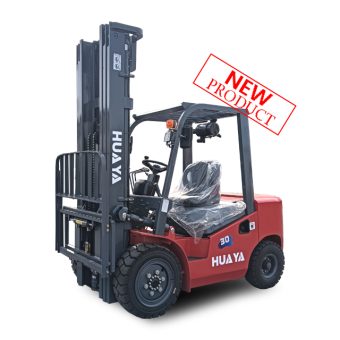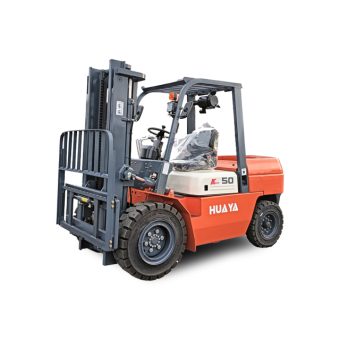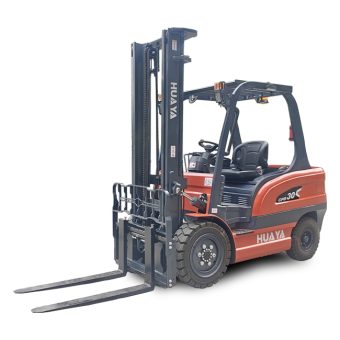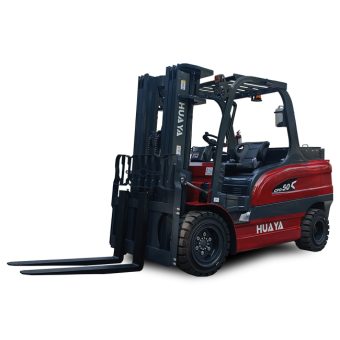
Новости
Вилочные погрузчики - незаменимые машины на складах, в логистических центрах и на промышленных площадках. Их универсальность часто повышается благодаря навесному оборудованию, такому как зажимы, вращатели и удлинители вил. Хотя эти аксессуары расширяют функциональность, они также напрямую влияют на номинальную грузоподъемность, баланс груза и общую безопасность вилочного погрузчика. Непонимание этой взаимосвязи может привести к неэффективной работе, дорогостоящим повреждениям и угрозе безопасности.
Номинальная грузоподъемность вилочного погрузчика означает максимальный вес, который вилочный погрузчик может безопасно поднимать при определенном центре нагрузки. Обычно этот показатель определяется производителем и четко обозначен на табличке грузоподъемности. Номинальная грузоподъемность зависит от конструкции машины, треугольника устойчивости и противовеса. При добавлении навесного оборудования номинальная грузоподъемность почти всегда уменьшается, поскольку навесное оборудование изменяет распределение веса, увеличивает расстояние между центрами нагрузки и расходует часть грузоподъемности погрузчика.
Навесное оборудование для вилочных погрузчиков - это специализированные инструменты, устанавливаемые вместо или в дополнение к стандартным вилам. Они позволяют вилочному погрузчику выполнять такие задачи, как вращение грузов, зажим рулонов бумаги или более эффективная обработка паллет. В качестве примера можно привести позиционеры вил, боковые переключатели, зажимы для коробок, вращатели и удлинители вил. Каждое навесное оборудование имеет свой вес и габариты, что изменяет эффективную грузоподъемность погрузчика. Операторы должны понимать, что навесное оборудование - это не просто аксессуары, а неотъемлемые части, которые изменяют производительность.
Центр тяжести имеет решающее значение для устойчивости вилочного погрузчика. Добавление навесного оборудования смещает центр тяжести погрузчика вперед, уменьшая его запас грузоподъемности. Более длинный центр тяжести увеличивает силу давления на вилочный погрузчик, требуя большего противовеса, чем тот, на который рассчитан погрузчик. Это объясняет, почему даже легкое навесное оборудование значительно снижает номинальную грузоподъемность. Оператор, поднимающий груз без учета этого смещения, рискует получить аварии с опрокидыванием, повреждения мачты и травмы персонала.
Навесное оборудование потребляет часть мощности вилочного погрузчика двумя способами:
Мертвый вес - само навесное оборудование создает дополнительный вес, который должен поднимать вилочный погрузчик.
Расширение грузового центра - навесное оборудование выдвигает груз дальше от мачты, увеличивая усилие и снижая грузоподъемность.
Например, если грузоподъемность вилочного погрузчика составляет 5 000 фунтов при 24-дюймовом центре нагрузки, добавление ротатора может снизить эту грузоподъемность на 800-1000 фунтов. Понимание этой взаимосвязи необходимо для безопасной работы с материалами.
Боковые переключатели: Позволяют перемещать груз влево или вправо без перестановки грузовика, что несколько снижает грузоподъемность.
Позиционеры вил: Регулируют расстояние между вилками, добавляя умеренный вес и снижая грузоподъемность.
Зажимы для рулонов бумаги: более тяжелая конструкция значительно снижает пределы подъема.
Ротаторы: Позволяют сбрасывать грузы, но значительно снижают номинальную грузоподъемность.
Удлинители вил: Увеличивают радиус действия груза, но снижают устойчивость и грузоподъемность.
Каждое навесное оборудование имеет особые требования к безопасности, поэтому необходимо ознакомиться с пересмотренной табличкой данных производителя.
Игнорирование того, как навесное оборудование влияет на грузоподъемность вилочного погрузчика, приводит к опасным ситуациям. Перегрузка может привести к опрокидыванию, падению груза или отказу гидравлики. Операторы вилочных погрузчиков, полагающие, что первоначальная грузоподъемность остается неизменной при использовании навесного оборудования, рискуют попасть в серьезную аварию. Регуляторы безопасности, такие как OSHA, подчеркивают, что таблички с данными должны отражать регулировку навесного оборудования. Обучение необходимо для предотвращения ошибок, которые приводят к травмам на рабочем месте и дорогостоящему повреждению оборудования.
Производители часто предоставляют пересмотренные графики грузоподъемности после установки навесного оборудования. Рассчитать вручную:
Вычтите вес навесного оборудования из номинальной грузоподъемности грузовика.
Учитывайте увеличение центра нагрузки, создаваемой навесным оборудованием.
Обратитесь к инженерным формулам или запросите обновленную табличку с данными у дилера вилочного погрузчика.
Благодаря этому операторы всегда знают предел безопасной нагрузки в реальных условиях.
Перед подъемом всегда проверяйте обновленную табличку грузоподъемности.
Проведите специальное обучение операторов работе с навесным оборудованием.
Регулярно осматривайте навесное оборудование на предмет износа, трещин и утечек гидравлики.
Подбирайте вложения в соответствии с приложением, а не навязывайте универсальное использование.
Избегайте самодельных или несанкционированных модификаций, которые снижают безопасность.
Следуя этим рекомендациям, предприятия снижают риски и повышают производительность.
Не все навесное оборудование подходит для каждого вилочного погрузчика или груза. Лица, принимающие решения, должны оценить:
Тип груза (картонные коробки, рулоны, паллеты, сыпучие материалы).
Окружающая среда (склад, двор, холодильная камера).
Частота использования привязанности.
Совместимость со спецификациями вилочных погрузчиков.
Правильный выбор инструмента обеспечивает безопасность, эффективность и долговечность оборудования.
Промышленность переходит на "умное" навесное оборудование, которое использует датчики для автоматической регулировки давления, контроля нагрузки и предотвращения перегрузок. Легкие материалы, такие как высокопрочные сплавы и композиты, также снижают собственный вес навесного оборудования, помогая вилочным погрузчикам сохранять большую грузоподъемность. Электрические и автоматические вилочные погрузчики все чаще интегрируют передовые системы навесного оборудования, обеспечивая более безопасные и эффективные операции в современных цепочках поставок.
Да, почти каждое навесное оборудование снижает грузоподъемность из-за дополнительного веса и изменения центра нагрузки.
Проверьте обновленную табличку с данными, предоставленную производителем или дилером.
Обычно от 100 до 300 фунтов, в зависимости от конструкции.
Потому что это напрямую влияет на силу воздействия на противовес вилочного погрузчика.
Да, но рекомендуется уточнять у производителя.
Это может привести к опрокидыванию, повреждению оборудования или несчастным случаям.
Да, OSHA требует наличия точных табличек с данными о производительности и обучения безопасной эксплуатации.
Да, но каждый из них требует пересчета мощности.
В целом, да, но тип груза и его использование имеют значение.
Перед эксплуатацией всегда проверяйте обновленную емкость.
Навесное оборудование для вилочных погрузчиков расширяет функциональность этих мощных машин, позволяя операторам работать с различными грузами в различных отраслях. Однако такая гибкость имеет свои недостатки - прежде всего, снижение номинальной грузоподъемности и ухудшение устойчивости. Навесное оборудование увеличивает собственный вес, смещает центр нагрузки, увеличивает нагрузку на гидравлику и противовесы. Игнорирование этих изменений может привести к серьезным авариям, повреждению оборудования и нарушению нормативных требований.
Чтобы добиться максимальной производительности без ущерба для безопасности, предприятия должны обучать операторов, следить за тем, чтобы обновленные таблички с данными о производительности были на виду, и выбирать навесное оборудование, соответствующее их уникальным задачам. Будущее обещает более умное и легкое навесное оборудование, которое минимизирует потери мощности и одновременно повышает производительность. До тех пор тщательный расчет, строгое соблюдение стандартов безопасности и осознанное принятие решений остаются ключом к безопасной и эффективной работе вилочных погрузчиков.
Понимая, как навесное оборудование влияет на производительность вилочного погрузчика, организации могут защитить работников, оптимизировать эффективность и продлить срок службы оборудования, гарантируя, что вилочные погрузчики останутся надежным инструментом в любой погрузочно-разгрузочной операции.



